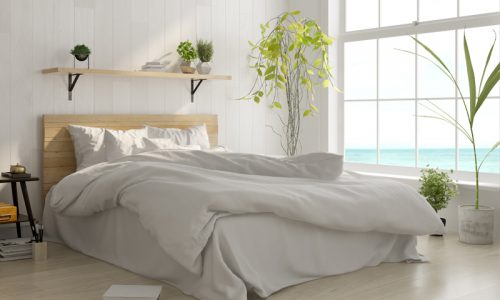
Can You Use Plaster In A Bathroom
- Interior Design
- January 26, 2024
Are you thinking about renovating your bathroom and considering using plaster? If so, you’re in the right place. In this article, we will explore the different types of plaster available and discuss which one is best suited for a bathroom.
Additionally, we will take you through the step-by-step process of plastering a bathroom and highlight the benefits and drawbacks of using plaster in this space. Whether you’re a DIY enthusiast or a homeowner looking for the best option for your bathroom, this article has got you covered.

Can You Use Plaster In A Bathroom?
Contents
When considering a bathroom renovation, one might wonder if the plaster is a suitable material to use. The use of plaster in a bathroom can bring various benefits, but it requires careful consideration of moisture resistance, application techniques, and long-term maintenance.
Plaster is a great choice for bathroom walls as it is naturally resistant to moisture, preventing dampness and mold growth. Its durability makes it ideal for wet environments, and its versatility allows for smooth finishes and intricate designs, enhancing the overall aesthetic of the space.
However, it is important to ensure proper waterproofing and maintenance, as any cracks or deterioration in the plaster can lead to water seepage and structural damage. Regular construction and inspection are necessary to address these concerns and prevent potential issues.
What Are The Types Of Plaster?
There are several types of plaster that can be used for various construction and renovation projects, each offering unique properties and applications. The main types of plaster include gypsum plaster, lime plaster, and cement plaster, all of which serve distinct purposes in the realm of construction materials.
Gypsum Plaster
Gypsum plaster is a widely used material in construction, known for its versatility and effectiveness in covering various surfaces such as walls and ceilings. Its application provides a smooth and durable finish, making it a popular choice for interior design projects.
Gypsum plaster is composed of calcium sulfate dihydrate. When mixed with water, it forms a paste that can be applied to surfaces. Over time, this paste hardens into a strong and resilient layer that can withstand everyday wear and tear.
One of the main reasons for using gypsum plaster in buildings is its excellent fire-resistant properties. This makes it a popular choice for improving fire safety. Additionally, its ability to be molded and shaped allows for intricate designs and architectural details to be incorporated into the interior space, enhancing the overall aesthetic appeal.

Lime Plaster
Lime plaster offers a traditional yet effective solution for surfacing and finishing, known for its aesthetic appeal and ease of repairs and maintenance.
Its application on various surfaces allows for a timeless and elegant finish in interior design and remodeling projects.
The unique characteristics of lime plaster include its ability to create a breathable surface, which helps in regulating moisture and reduces the risk of mold and mildew.
Its natural composition makes it environmentally friendly and safe for indoor use. In terms of maintenance, lime plaster is easily repairable, allowing for seamless touch-ups and corrections.
Its versatility also extends to its compatibility with a wide range of decorative techniques, enabling endless possibilities for creating bespoke and visually stunning interior spaces.

Cement Plaster
Cement plaster stands out for its exceptional durability and waterproofing capabilities, making it a preferred choice for construction projects that necessitate robust moisture protection.
Its application involves effective sealing techniques, ensuring long-term resilience in various environments.
This versatile construction material provides superior protection against water ingress, which is critical for maintaining the structural integrity of buildings.
Cement plaster is known for its reliability in withstanding harsh weather conditions, making it an ideal choice for both interior and exterior applications.
The use of cement plaster also aligns with building codes and regulations, emphasizing its importance in ensuring the safety and longevity of constructed spaces.

What Is The Best Type Of Plaster For A Bathroom?
Selecting the best type of plaster for a bathroom involves considering crucial factors such as moisture resistance, durability, and suitability for various surfaces.
Identifying the ideal plaster for a bathroom renovation project requires careful evaluation of these essential attributes.
Moisture resistance is particularly vital in bathrooms where high humidity levels can deteriorate traditional plaster. Waterproofing and moisture-resistant plasters, such as cement-based or gypsum-based plasters, are excellent choices to combat these challenges.
The plaster’s durability is crucial for withstanding the daily wear and tear in a bathroom environment. When choosing a plaster, it’s essential to consider its suitability for different surfaces, whether it be for walls, ceilings, or even shower areas. This ensures that the plaster meets the specific requirements of each area during the renovation process.
What Are The Properties Of The Best Plaster For A Bathroom?
The best plaster for a bathroom should exhibit exceptional water resistance, low maintenance requirements, and the ability to enhance the overall aesthetics of the space.
These properties are essential for ensuring the longevity and visual appeal of the plaster in a moisture-prone environment.
Proper moisture protection is crucial to prevent the formation of mold and mildew, which can compromise the structural integrity of the bathroom.
A plaster that requires minimal repairs and upkeep will save time and effort in maintaining the bathroom’s interior.
The choice of plaster can significantly impact the overall design and ambiance of the space, making it imperative to select a material that complements the desired aesthetic and style.

What Are The Steps To Plaster A Bathroom?
Plastering a bathroom involves several key steps, including meticulous surface preparation, precise application of the plaster, and the crucial process of achieving a smooth and impeccable finish. These steps are vital for ensuring the successful plastering of a bathroom space.
The first step in the process is to thoroughly clean and dry the surfaces to be plastered. This may involve removing any existing wallpaper, old plaster, or paint, and ensuring that the wall or ceiling is free from dust and debris.
Once the surface is clean, it’s important to apply a waterproof plaster or sealing compound to provide a moisture-resistant base for the new plaster. When applying the plaster, it’s essential to use the proper techniques to create an even and consistent layer, followed by careful smoothing and finishing for a professional-looking result.
Prepare The Surface
Preparing the surface for plastering in a bathroom involves thorough ventilation and meticulous moisture protection measures to ensure the longevity and integrity of the plaster. Adequate surface preparation sets the foundation for a successful and durable plaster application.
Proper ventilation is crucial in preventing excess moisture from damaging the plaster over time. This can be achieved by implementing moisture-resistant materials and following construction and building codes. These measures not only enhance the bathroom’s aesthetic appeal but also ensure a strong foundation for the plaster, reducing the need for frequent maintenance or repairs.
Mix The Plaster
The process of mixing plaster for a bathroom project involves selecting the appropriate construction materials and ensuring the incorporation of waterproofing elements to enhance the moisture resistance of the final application. A well-prepared plaster mix is essential for achieving a durable and resilient finish.
Careful consideration should be given to the type of plaster and additives used. A focus on moisture-resistant materials is crucial to combat the humidity levels commonly found in bathrooms.
Waterproofing membranes, primers, and sealants also play a crucial role in preventing water seepage and protecting the underlying structural elements from moisture damage. By meticulously addressing these aspects during the plaster mixing process, the overall moisture resistance and longevity of the bathroom renovation can be significantly improved.

Apply The First Coat
The initial application of the first coat of plaster in a bathroom requires precision and effective techniques to ensure an even and consistent coverage across the designated surfaces. Proper application methods are crucial for establishing a solid foundation for subsequent plaster layers.
This process involves carefully spreading the plaster mixture using a trowel. It is important to ensure that the coat is even and free of air pockets. Construction professionals emphasize achieving a smooth and seamless application, as this impacts the overall durability and aesthetic appeal of the surface.
The careful attention to detail during this step lays the groundwork for a successful remodeling project. It sets the stage for subsequent layers of plaster and paint to adhere smoothly and flawlessly.

Apply The Second Coat
Applying the second coat of plaster in a bathroom involves the utilization of specific techniques and potential alternatives to achieve the desired finish and durability.
The choice of application methods significantly impacts the overall quality of the plastered surfaces. Proper technique is crucial to ensure that the second plaster coat adheres well to the first coat and the surface beneath. Some options include using a trowel for a smooth and consistent application or a plastering hawk and trowel for larger areas.
Alternatively, some renovators opt for a sprayer application for a more efficient and faster process. The chosen technique can influence the final texture and appearance, ensuring it aligns with the overall interior design scheme of the bathroom renovation.
Smooth Out The Surface
Achieving a uniformly smooth surface in a bathroom after plaster application requires meticulous attention to detail, potential repairs, and the consideration of the surface’s aesthetics.
The final smoothing process contributes to the overall maintenance and visual appeal of the plastered bathroom walls and ceilings.
When it comes to plastered surfaces, it’s crucial to prioritize both visual appeal and durability. This means taking the time to smooth out imperfections and uneven spots, not just for aesthetics but also to prevent potential issues like cracks and water damage.
This meticulous finishing process can greatly enhance the overall interior design of a bathroom, creating a polished and cohesive look. Additionally, properly smoothed plaster surfaces make cleaning and maintenance much easier, resulting in a long-lasting and well-maintained bathroom.
What Are The Benefits Of Using Plaster In A Bathroom?
The utilization of plaster in a bathroom presents numerous benefits, including exceptional water resistance, long-term durability, and the ability to enhance the overall aesthetics of the space. These advantages contribute to the appeal of plaster in bathroom projects.
The moisture protection provided by plaster makes it an ideal choice for bathroom walls and ceilings. It effectively inhibits the growth of mold and mildew, ensuring a clean and healthy environment.
Additionally, plaster’s durability makes it perfect for withstanding the humid conditions of a bathroom. This offers a long-lasting solution that requires minimal maintenance.
The versatility of plaster also allows for various textures and finishes, adding depth and character to the bathroom’s interior design. With its seamless application, plaster can create a luxurious and cohesive look, elevating the ambiance of the entire bathroom.

Water Resistance
The exceptional water resistance of plaster in a bathroom ensures effective moisture protection and the necessity for proper sealing techniques, contributing to the longevity and integrity of the plastered surfaces in moisture-prone environments.
This level of water resistance is crucial in ensuring that the construction materials used in the bathroom can withstand constant exposure to moisture. Proper sealing not only prevents water from seeping into the plaster but also enhances its overall resilience to the challenging conditions of a bathroom.
The ability of plaster to repel water plays a significant role in maintaining the structural stability and aesthetic appeal of the bathroom, making it an indispensable element in effective waterproofing and moisture management.
Durability
The inherent durability of plaster in a bathroom reduces the need for frequent maintenance and repairs, providing long-term reliability and stability in the face of moisture and environmental factors. Its durable nature contributes to the sustainable functionality of the plastered surfaces.
This robustness makes plaster an ideal choice for bathroom renovations, as it can withstand the rigors of daily use and exposure to moisture.
While periodic maintenance, such as resealing or repainting, is essential to uphold its moisture resistance, plaster’s ability to withstand these conditions over time underscores its long-term reliability. Its ease of repair and ability to integrate seamlessly with various design styles add to its appeal in creating enduring, visually pleasing bathroom spaces.
Mold Resistance
The mold resistance of plaster in a bathroom is crucial for maintaining a hygienic and healthy environment. This necessitates proper ventilation and effective measures for moisture protection. Its mold-resistant properties contribute to the overall well-being of the bathroom space.
By incorporating moisture-resistant plaster, the bathroom is better safeguarded against the detrimental effects of moisture buildup, such as mold and mildew. Adequate ventilation plays a pivotal role in preventing excessive humidity, which is a common catalyst for mold growth.
A well-ventilated bathroom not only ensures greater comfort but also assists in the maintenance of cleanliness and hygiene. Proper maintenance and attention to moisture-resistant materials can significantly prolong the lifespan and appeal of the bathroom.
Aesthetics
Plaster contributes to the enhancement of the bathroom’s aesthetics, offering a versatile and customizable surface for interior design and remodeling projects. Its visual appeal adds a sense of elegance and sophistication to the overall ambiance.
The use of plaster in bathroom renovation facilitates the creation of unique textures, finishes, and artistic elements, allowing for personalized and stylized expressions in the space. Whether it’s a smooth, polished surface or a textured, rustic look, plaster provides flexibility to suit various design preferences.
Its seamless application on walls and ceilings creates a cohesive and visually captivating environment, amplifying the luxurious and refined character of the bathroom. This material significantly contributes to elevating the overall aesthetic allure of the space, making it a valuable choice for interior designers and homeowners seeking to enhance the visual impact of their bathroom.
What Are The Drawbacks Of Using Plaster In A Bathroom?
Despite its numerous benefits, using plaster in a bathroom presents certain drawbacks, including potential costs, time-consuming application processes, and challenges associated with repairs and maintenance. These factors should be carefully considered when deciding on the use of plaster in a bathroom project.
The cost considerations of using plaster in a bathroom can be significant, as it often requires skilled professionals to apply and maintain. The time-consuming application processes for plaster can prolong renovation projects, causing inconvenience and potential delays.
Repairs and maintenance of plaster in a bathroom can be challenging, as it is prone to cracking and may require specialized techniques to restore its integrity. These factors emphasize the need for thorough evaluation before choosing plaster for bathroom construction and renovation.

Cost
The cost of using plaster in a bathroom can be a significant factor to consider, as it may impact the overall budget for the remodeling or construction project.
Careful cost assessments are essential for making informed decisions regarding the use of plaster in a bathroom renovation.
The expense of using plaster in a bathroom encompasses various aspects, including the materials themselves, installation costs, and long-term maintenance.
When compared to traditional tiles, waterproof plaster may offer cost savings, as it requires less labor and can be applied more efficiently.
It’s crucial to factor in any additional treatments or sealants needed to ensure the plaster’s durability in wet environments.
Considering the potential savings on labor and materials, some homeowners may find that using plaster is a cost-effective choice for their bathroom renovation projects.
Discover: How Much Is Plastering A Room
Time-Consuming
The application of plaster in a bathroom can be time-consuming, requiring meticulous techniques and attention to detail to achieve the desired finish. Potential maintenance needs may contribute to the overall time investment in using plaster for the bathroom.
The process of applying plaster involves several steps. These include preparing the surface, mixing the plaster, and carefully applying it to the walls or ceiling. Each step requires precision and dedication, which can add to the overall time needed for a renovation project.
Once the plaster is in place, it may also require periodic maintenance. This could include resealing or repairing cracks, which can further extend the time commitment. Therefore, individuals undertaking DIY projects involving plaster in a bathroom should consider the time-intensive nature of this material and the potential long-term maintenance requirements.
Difficult To Repair
The inherent challenges associated with repairing plaster in a bathroom, particularly in moisture-prone environments, can pose difficulties and complexities.
Addressing repair needs effectively requires careful consideration of the plaster’s long-term maintenance and its impact on the overall construction integrity. This is especially crucial in bathrooms, where waterproofing is essential to prevent moisture-related damage. The repair process must align with building codes and standards to ensure the structural and aesthetic integrity of the space.
The complexities of repairing plaster in a bathroom involve identifying and addressing underlying issues that may compromise the durability and longevity of the repair. Factors such as ventilation, material compatibility, and professional expertise play critical roles in achieving a successful and lasting plaster repair in such environments.





